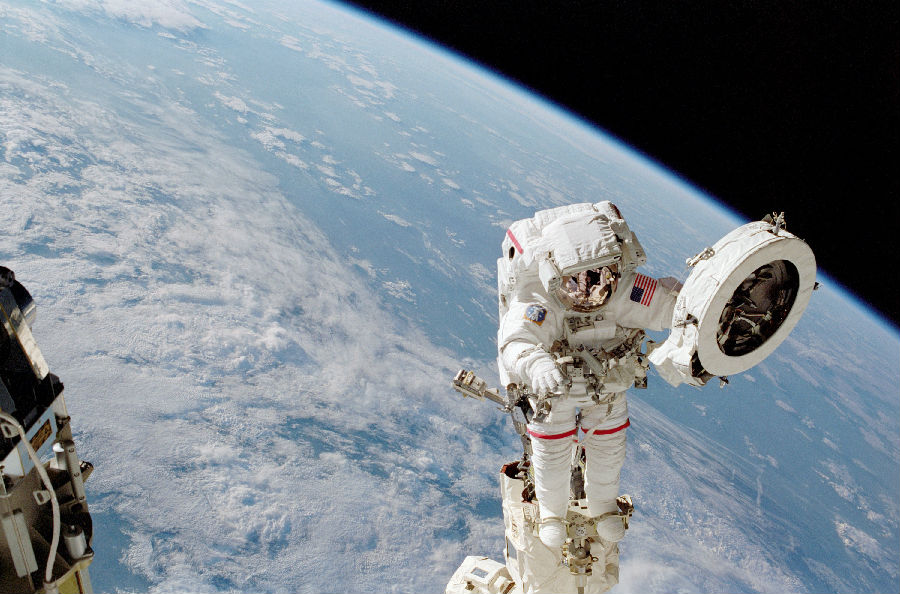From planetary orbit, the earth and heavens look serene. But the vacuum of space is a hostile environment, lacking oxygen and permeated by radiation. Since the advent of manned space flight in the 1960s, humankind has been exploring this inhospitable realm from the relative safety of spacecraft. But occasional extravehicular activities have led astronauts to leave these confines and explore the unknown. In order for astronauts to survive in space, spacesuits provide a self-contained environment. Their tough material, along with heating and cooling elements, protect astronauts from extreme temperatures, ranging from around 250 degrees Fahrenheit to minus 250 degrees. The suits are pressurized with pure oxygen, allowing astronauts to breathe and keep their blood from boiling in the vacuum of space.
從行星軌道上看,地面和天空看起來都是一片寧靜。但宇宙是真空的,不適合人類生存,因為缺乏氧氣,而且到處都有輻射。自從上世紀60年代出現載人太空飛行以來,人類一直在從相對安全的宇宙飛船中探索宇宙這個荒蕪之地。但有時候,艙外活動時,宇航員也可以走出桎梏,探索未知。為了讓宇航員在太空中生活下來,就要依靠太空服來提供獨立的環境。太空服材質堅固,自帶加熱和冷卻功能,可以保護宇航員不受極端溫度的傷害,這里說的極端溫度是指250華氏度-零下250華氏度。太空服里密封了純氧氣,這樣宇航員既可以呼吸,又可以在真空的太空環境中免于血液燒騰。

The first venture outside the spacecraft was made by Soviet cosmonaut Alexey Leonov in 1965, lasting only 12 minutes. This feat was duplicated a few months later by American astronaut Edward White during the Gemini 4 mission. Although these excursions were meant to test the feasibility of humans to exist outside the spacecrafts, spacewalks have become a relatively common part of missions in the space shuttle era. On spacewalks, astronauts have performed vital tasks that could not be accomplished from inside the shuttle. They've been able to recover lost satellites, restoring them to their proper orbit. They have serviced orbiting bodies, like replacing the solar panels on the Hubble Space Telescope. And they have become the construction crew for the International Space Station.
第一次進行艙外探索的人是蘇聯宇航員阿列克謝·列昂諾夫,那時候是1965年,他的艙外探索僅持續了12分鐘。數月后,美國宇航員愛德華·懷特在執行雙子座4號任務期間也進行了艙外探索。雖然艙外的短途活動只是為了測驗人類是否能在宇宙飛船外活動,但太空漫步已經成為航天飛機時代一個相對常見的任務之一。正是通過太空漫步,宇航員才得以執行一些關鍵性任務,而這些任務是在艙內做不到的,比如保養環繞軌道飛行的衛星,替換哈勃望遠鏡上的太陽電池板。宇航員已儼然成為國際空間站的施工人員。
Conducting spacewalks is dangerous, and astronauts work in pairs, tethered to the spacecraft for safety. Walking in these spacesuits is not as easy as it seems. The thick pressurized gloves make grasping tools difficult, while the weightlessness of space creates its own issues. To ensure spacewalk missions are successful, astronauts practise their planned excursions at NASA’s Neutral Buoyancy Laboratory. Immersed in a tank of water, the astronauts neither sink nor float, creating a sensation close to weightlessness. For every hour a task is scheduled on a mission, up to 10 hours is spent practicing underwater.
太空漫步很危險,所以宇航員會組隊進行,就算這樣也要通過繩索與宇宙飛船相連,以保證安全。穿著太空服漫步并不像看起來那樣簡單。由于太空服厚厚的手套經過了密封,所以拿工具就成了一件難事,而且太空里是失重的,所以還引發一些困難。為了確保艙外任務順利進行,宇航員在美國宇航局的無重力實驗室進行經過計劃籌備的短途活動。宇航員會置身于一缸水里,在其中,他們既不會漂浮也不會下沉,這就營造了一種類似失重的體驗。艙外執行任務中的一小時,就意味著臺下10小時的水下練習功。
As NASA moves forward on the maintenance and construction of the International Space Station, spacewalks will continue to be vital to the process.
在未來,美國宇航局會繼續進行國際空間站的維護和建造,而太空漫步也將在其中發揮關鍵性作用。











